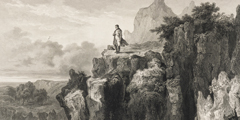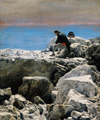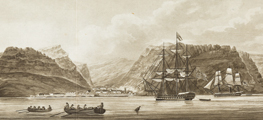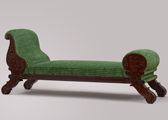1. From the élysée palace to st Helena
Waterloo. 18 June, 1815, 9-15pm.The French army commanded by Napoleon I was defeated by a British force under the orders of the Duke of Wellington, and by Prussian soldiers under Marshal Blücher. The defeated Emperor returned to Paris on horseback.
Exhausted and discouraged, he reached the Élysée Palace on 21 June, only to be faced with another defeat. Under pressure from the two Chambers of government, he abdicated in favour of his son, then five years old. He suggested that he could become a simple general and defend France from invasion, but the Provisional Government constituted and gathered around Fouché, ex-Minister of Police, showed him the door and the road to exile. A small entourage was quickly constituted around him. The clothes, table services, and silverware that were packed into boxes for the exile were simply those which fell to hand.
Here began the fallen Emperor’s long road from Paris to Longwood House, on the island of St Helena, passing via Malmaison, the Ile d’Aix, and the English south coast.
2. Island prison
The European powers considered the fallen Emperor a prisoner. Britain was designated as responsible for his detention, but under the watchful eye of commissioners which Austria, Russia, Prussia, and France were to send.Given that St Helena was 2,000 km off the coast of West Africa and 5,600 km east of Buenos Aires, the island was the perfect choice as far as discouraging escape attempts was concerned. It belonged to the British East India Company and was a stopping off point for merchant vessels en route for the Indies. Defence of the St Helena coastline was beefed up with military units added to those already stationed on the island. For the period of Napoleon’s detention, the island was to be run by a Lieutenant General answerable directly to the British Minister for the War and the Colonies. Admiral Cockburn was the first incumbent, and he was replaced by Sir Hudson Lowe, who arrived on 14 April, 1816.
At the beginning of Napoleon’s exile, newspapers and caricaturists gleefully underlined the disparity between the image that Napoleon had carefully constructed for himself (and to which he remained more than ever attached), namely, a limitless ambition, compared to his tiny domain on the island.
3. Longwood house, the final residence
As for a place to live, the Governor’s residence, Plantation House, was out of the question. For the time that a suitable place was being prepared, Admiral Cockburn installed Napoleon on the domain at the Briars. Napoleon lived there in a small pavilion, kindly cared for by the owners, the Balcombe family. The cheeky behaviour of the youngest daughter, Betsy, brightened slightly Napoleon’s melancholy days.On 10 December, he moved to Longwood Farm, on a barren plain. There, the terrain acted as a brake on the clouds, creating one of the least sunny and most-humid places on the whole island. The weather was most frequently dominated by wind and mist, even in summer. The only view of the sea was rarely clear.
Guard houses were built to control the one road into Longwood. On the leaving the area where he had freedom of movement, Napoleon had to be accompanied by a British officer. He refused. Nor did he go to the Governor’s dinners, where his imperial status would not be recognised. As for the horse races, one of the island’s principal entertainments, he watched from far off through a telescope.
He allowed the space to close in around him, vicelike.






